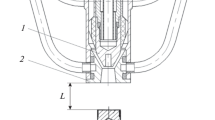Abstract
Implementation of plasma technologies widely introduced into modern industrial processes requires plasma generators with a high efficiency, great economy, and long lifetime. The last requirement is caused by the necessity of an increase in the lifetime of the most easily worn plasmatron elements, i.e., the electrodes and, primarily, their cathode units. Thermoemission cathodes made of tungsten, the most refractory metal with the melting point T m = 3695 K, are widely exploited in high-current (I = 300–1000 A) plasmatrons operating in oxygen-free media (inert gases like nitrogen and hydrogen). By the middle of the 1980s, due to the discovery and application of the phenomenon of the recirculation of electrode material in the cathode zone, erosion of the cooled thermocathode was successfully reduced to G = 10–10 g/C. The present study performed by means of a plasmatron with a self-adjusting arc length concerns important problems, such as measurement of the emission current, determination of cathode material erosion, and analysis of means of enhancement of the thermoemission cathode lifetime. Through the investigations performed and the resource tests of the above-mentioned plasmatron type with currents of 300–500 A, with nitrogen as the working gas, the requirements for the cathode and the plasmatron operating regimes providing for its low erosion losses, G ≤ 10–10 g/C, at a cathode surface temperature close to its melting point are determined. The experimentally obtained densities of the electron emission currents exceed, by an order of magnitude, those calculated according to the Richardson–Dushman theory with the Schottky correction and with account for the photoemission on the cathode under the action of the resonance emission generated by the positive column of the arc. In that connection, attention is paid to the mechanism of the anomaly electron emission proposed by S.V. Lebedev and caused by occurrence of the Frenkel defect accompanied by crystal lattice deformation, Fermi energy increase, and the respective decrease in the electron-from-metal work function. The obtained estimates of the Frenkel defect concentration in tungsten at the premelting temperatures are a cogent argument in favor of the anomaly electron emission concept.
Similar content being viewed by others
References
Isakaev, E.Kh., Sinkevich, O.A., Tyuftyaev, A.S., and Chinnov, V.F., High Temp., 2010, vol. 48, no. 1, p. 97.
Belevtsev, A.A., Goryachev, S.V., Isakaev, E.Kh., and Chinnov, V.F., High Temp., 2013, vol. 51, no. 5, p. 583.
Belevtsev, A.A., Isakaev, E.Kh., Markin, A.V., Khaimin, V.A., and Chinnov, V.F., High Temp., 2000, vol. 38, no. 5, p. 667.
Zhukov, M.F., Koroteev, A.S., and Uryukov, B.A., Prikladnaya dinamika termicheskoi plazmy (Applied Thermal Plasma Dynamics), Novosibirsk: Nauka, 1975.
Zhukov, M.F., An’shakov, A.S., and Dandaron, G.-N.B., in Prielektrodnye protsessy i eroziya elektrodov plazmotronov (Near-Electrode Processes and Erosion of Electrodes of Plasma Torches), Novosibirsk: Inst. Teplofiz., Sib. Otd. Akad. Nauk SSSR, 1977, p. 123.
Nizkotemperaturnaya plazma (Low-Temperature Plasma) Zhukov, M.F., Zasypkin, I.M., Ed., Novosibirsk: Nauka, 1990.
Nemchinsky, V., J. Phys. D: Appl. Phys., 2003, vol. 36, no. 13, p. 1573.
Nemchinsky, V.A. and Showalter, M.S., J. Phys. D: Appl. Phys., 2003, vol. 36, no. 6, p. 704.
Asinovsky, E.I., Isakaev, E.Kh., Ivanov, P.P., Ochkan, A.L., and Samoylov, I.S., High Temp. Mater. Proc. Int. J., 2004, vol. 8, no. 4, p. 599.
Moizhes, B.Ya. and Nemchinskii, V.A., Zh. Tekh. Fiz., 1971, vol. 42, no. 5, p. 1001.
Fridlyand, M.G. and Nemchinskii, V.A., K teorii katoda postoyanno vozobnovlyayushchegosya iz uglerodsoderzhashchei atmosfery dugi, Izv. Sib. Otd. Akad. Nauk SSSR, Ser. Tekh. Nauk, 1987, vol. 13, no. 3, p. 52.
Chinnov, V.F., High Temp., 2002, vol. 40, no. 4, p. 360.
Lebedev, S.V. and Savvatimskii, A.I., Phys.–Usp., 1984, vol. 27, no. 10, p. 749.
Van Bueren, H.G., Imperfections in Crystals, Amsterdam, North-Holland, 1960.
Butyagin, P.Yu., Khimicheskaya fizika tverdogo tela (Chemical Physics of Solid State), Moscow: Mosk. Gos. Univ., 2006.
Schmidt, W.F. and Yoshino, K., in Electronic Excitations in Liquefied Rare Gases, Schmidt, W.F. and Illenberger, E., Eds., San Francisco: Am. Sci. Publ., 2005, p. 296.
Khrapak, A.G. and Yakubov, I.T., Elektrony v plotnykh gazakh i plazme (Electrons in Dense Gases and Plasma), Moscow: Nauka, 1981.
Author information
Authors and Affiliations
Corresponding author
Additional information
Original Russian Text © A.A. Belevtsev, S.V. Goryachev, E.Kh. Isakaev, V.F. Chinnov, 2016, published in Teplofizika Vysokikh Temperatur, 2016, Vol. 54, No. 6, pp. 843–850.
Rights and permissions
About this article
Cite this article
Belevtsev, A.A., Goryachev, S.V., Isakaev, E.K. et al. Lifetime of the thermoemission cathodes of nitrogen plasma generators. High Temp 54, 789–795 (2016). https://doi.org/10.1134/S0018151X16040052
Received:
Published:
Issue Date:
DOI: https://doi.org/10.1134/S0018151X16040052



